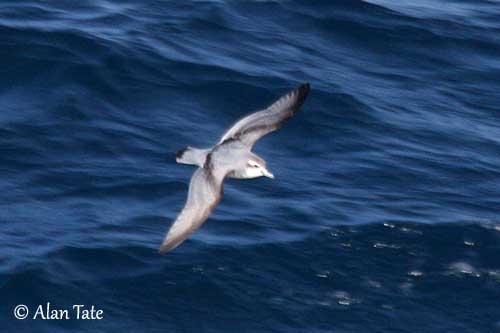
Fr: Prion de Belcher
Ang: Slender-billed Prion – Thin-billed Prion
All: Dünnschnabel-Sturmvogel
Esp: Prión picofino
Ita: Prione beccosottile
Nd: Dunbekprion
Sd: Smalnäbbad valfågel
Photographers:
John Anderson
John Anderson Photo Galleries
Alan & Ann Tate
AA Bird Photography
Text by Nicole Bouglouan
Sources:
HANDBOOK OF THE BIRDS OF THE WORLD vol 1 by Josep del Hoyo-Andrew Elliot-Jordi Sargatal - Lynx Edicions - ISBN: 8487334105
A Complete Guide to Antarctic Wildlife by Hadoram Shirihai and Illustrated by Brett Jarrett - Edited by Guy M. Kirwan - ALUL.A Press Oy, Finland - ISBN 9519894705
BirdLife International (BirdLife International)
Department of Sustainability, Environment, Water, Population and Communities
New Zealand birds and birding (Narena Olliver)
Wikipedia, the free encyclopaedia
Slender-billed Prion or Thin-billed Prion
Pachyptila belcheri
Procellariiformes Order – Procellariidae family
INTRODUCTION:
The Slender-billed Prion is very similar to the five other species of genus Pachyptila. It is a very typical prion with the dark M-shaped pattern across the upperwing. This species is common in Southern Ocean and breeds on subantarctic islands where it nests in burrow on coastal slopes. It is gregarious while feeding at sea at abundant food sources. They breed colonially and are monogamous.
DESCRIPTION OF THE BIRD:
Biometrics:
Length: 25-28 cm
Wingspan: 56 cm
Weight: 145 g
The adult has pale grey to pale grey-blue upperparts including wings and tail, slightly darker on forehead and crown. The upperwing has a transversal dark M from wingtip to wingtip. The uppertail is paler on sides, with black band on central tips.
The underparts are entirely white including underwing and undertail, except the dark area on central rectrices.

On the head, there is a large white supercilium extending from lores to behind the eye. It contrasts with a dark mask extending from lores to ear-coverts, meeting at rear the pale grey neck sides.
The Slender-billed Prion has the narrowest and less robust bill of all prions. It is blue-grey with black culmen. The eyes are blackish brown. Legs and webbed feet are blue to greyish with mostly pinkish webs.
Both adults are similar, but the male is larger than the female.
The juvenile resembles adults.
RANGE:
The Slender-billed Prion occurs in Southern Ocean. It breeds on subantarctic islands such as Crozet and Kerguelen Islands, and also on Noir Island off S Chile, and in the Falkland Islands.
HABITAT:
The Slender-billed Prion’s colonies are established on islands on coastal slopes with tussock grass. The burrow is excavated in soft soil, but this species may also nest under rocks and in rocky crevices.
Outside the breeding season, it is marine and pelagic, usually keeping far out to sea. Prions can be found South, in the vicinity of the pack ice.
CALLS AND SONGS: SOUNDS BY XENO-CANTO
The Slender-billed Prion is usually silent at sea, but it becomes more vocal on the ground at night at colonies. The commonest call is a soft, dove-like crooning. Other sounds include harsh chattering calls. The bird utters a single-note call in flight, usually a piping whistle. Male and female give different vocalizations.
BEHAVIOUR IN THE WILD:
The Slender-billed Prion feeds primarily on crustaceans, mainly amphipods, but also crustaceans of genus Euphausia. Small fish and squid are also part of its diet.
Unlike other Pachyptila prions, this species does not take copepods, probably due to the lack of lamellae within the bill.
The Slender-billed Prion feeds by surface-seizing and surface-diving, reaching at least 6-7 metres below the surface. It also performs dipping while in flight and pattering. It feeds mainly at night to avoid predation, and it is gregarious at sea, often foraging with Antarctic Prions. It rarely follows ships.

The Slender-billed Prion is loosely colonial. The adults perform a pre-laying exodus during about three weeks after the copulation and prior to the laying. They are monogamous with long-term pair-bonds.
This species is very aggressive towards other prions, and compete for nesting sites with the Blue Petrel on Kerguelen Islands. They are exclusively nocturnal at colonies in order to avoid predation by skuas.
Most courtship and sexual activities occur inside the burrow, and largely consist of “billing” and mutual preening.
The Slender-billed Prion disperses widely after breeding over the Southern Ocean. The Falklands’ birds are regular visitors to South Georgia and are recorded off W South America, usually off S Chile. This species disperses N to Java, W Australia, New Zealand, W Peru, S Brazil and South Africa.
Like all members of the family Procellariidae, the Slender-billed Prion is a good flier in spite of the shorter wings. The flight is very active and erratic, and the bird manoeuvres at great speed.

REPRODUCTION OF THIS SPECIES:
The breeding season starts in October/November in Falklands, and later on Kerguelen.
It nests in self-excavated burrow in soft soil on grassy coastal slopes. The burrow is about 0,6-3,5 metres deep, and is lined with grass and feathers.
The female lays a single white egg. Both adults share the incubation during 46-47 days with stints of 4-7 days. At hatching, the chick is covered with grey down overall. It is fed by both parents and fledges 49-50 days after hatching.
PROTECTION / THREATS / STATUS:
The Slender-billed Prion is affected by predation by introduced cats and rats, and by natural predators such as Striated Caracara and skuas on some breeding islands. However, the recent elimination of some introduced predators has involved increase and expansion of populations in Falklands.
The global population is estimated at least as 7,000,000 individuals, and is suspected to be stable.
The Slender-billed Prion is currently evaluated as Least Concern.
